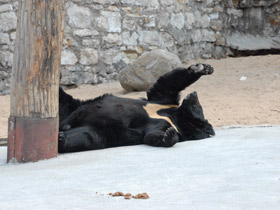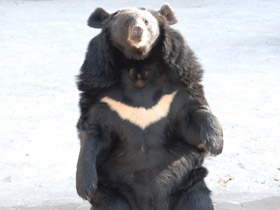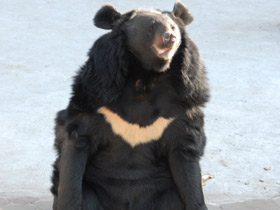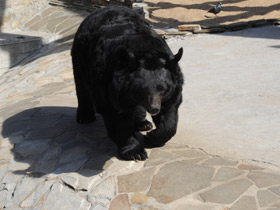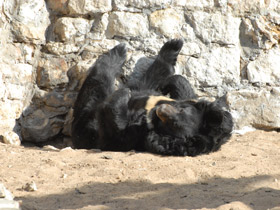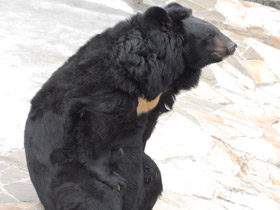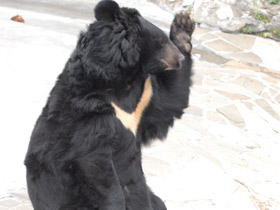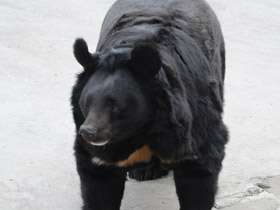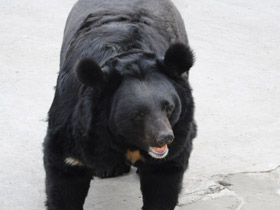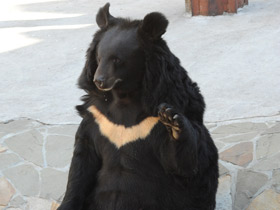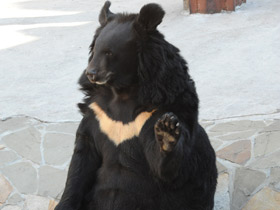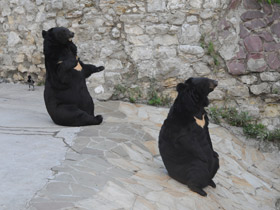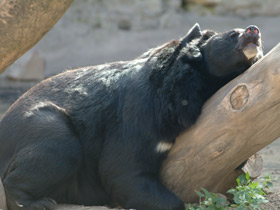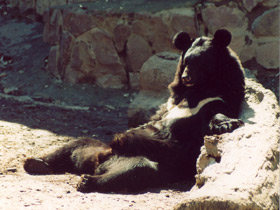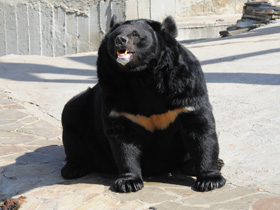The Asian black bear, the Asiatic black bear, moon bear and white-chested bear(Ursus thibetanus)
The Asian black bear (Ursus thibetanus), also known as the Asiatic black bear, moon bear and white-chested bear, is a medium-sized bear species native to Asia that is largely adapted to an arboreal lifestyle. It lives in the Himalayas, southeastern Iran, the northern parts of the Indian subcontinent, the Korean Peninsula, China, the Russian Far East, the islands of Honshū and Shikoku in Japan, and Taiwan. It is listed as vulnerable on the IUCN Red List, and is threatened by deforestation and poaching for its body parts, which are used in traditional medicine.
Appearance and lifestyle
Ursus thibetanus is a species of carnivorous mammal of the Ursidae family.
Ursus thibetanus is about half the size of the dun and differs from the dun by its slimmer build, pointed snout and large rounded ears. Its dense, fluffy coat, especially long on the shoulders and neck, is pure black, excluding the white or yellowish patch on the chest, reminiscent of the Latin letter V or crescent shape - hence the name Moon Bear (also called White-chested Bear). Unlike Ursus arctos, Ursus thibetanus leads a semi-woodland life, foraging in trees, where it flees from enemies and mosquitoes. Its sharp hooked claws and strong paws allow the Himalayan bear to easily climb to the top of the tallest tree. The Himalayan is also quite fast on land, loves water and is a good swimmer.
Distribution and habitat
Fossil record indicate that the Asian black bear once ranged as far west as Western Europe, though it now occurs very patchily throughout its former range, which is limited to Asia. Today, it occurs from southeastern Iran eastward through Afghanistan and Pakistan, across the foothills of the Himalayas in India and Myanmar to mainland Southeast Asia, except Malaysia. Its range in northeastern and southern China is patchy, and it is absent in much of east-central China. Other population clusters exist in the southern Russian Far East and in North Korea. A small remnant population survives in South Korea. It also occurs on the Japanese islands of Honshu and Shikoku, as well as on Taiwan and the Chinese island of Hainan.
It typically inhabits deciduous forests, mixed forests and thornbrush forests. In the summer, it usually inhabits altitudes of around 3,500 m (11,480 ft) in the Himalayas but rarely above 3,700 m (12,000 ft). In winter, it descends to altitudes below 1,500 m (4,920 ft). In Japan, it also occurs at sea level.
There is no definitive estimate as to the number of Asian black bears: Japan posed estimates of 8–14,000 bears living on Honshū, though the reliability of this is now doubted. Although their reliability is unclear, rangewide estimates of 5–6,000 bears have been presented by Russian biologists. In 2012, Japanese Ministry of the Environment estimated the population at 15–20,000. Rough density estimates without corroborating methodology or data have been made in India and Pakistan, resulting in the estimates of 7–9,000 in India and 1,000 in Pakistan. Unsubstantiated estimates from China give varying estimates between 15 and 46,000, with a government estimate of 28,000.
Nutrition
The bear's diet consists of 85% plant foods: pine nuts, hazelnuts, Manchurian and pine nuts, acorns, berries and various fruits, grass shoots and shrubs, succulent bulbs and rhizomes. Like all bears, it eats ants and other insects, collects molluscs, hunts frogs and rodents and is fond of honey. The remains of other predators' meals and carrion are usually eaten by Ursus thibetanus only after it leaves the den, when it is very emaciated. Ungulates are rarely hunted by this predator.
Hibernation and reproduction
Ursus thibetanus hibernates during the winter. However, it does not sleep on the ground, like its brown companion, but in softwood hollows, such as poplar or lime, at a height of 2 to 10 metres above the ground. However, if there are no such trees, the Himalayan may build a nest on the ground or use niches and crevices in rocks as a den.
In January or February females give birth to 1 or 2 young weighing between 300 and 400 g. The young develop slowly and are completely defenceless, even at one month of age. The lactation period lasts between 3 and 3.5 months. Young Ursus thibetanus live with their mother until the end of the second summer, often sleeping with her in the den.
Subspecies
Seven subspecies are recognised with the following geographic distribution:
- Ursus thibetanus formosanus, Taiwan.
- Ursus thibetanus gedrosianus, south-eastern Iran and central and southern Pakistan.
- Ursus thibetanus japonicus, Japan.
- Ursus thibetanus laniger, Himalayan range, Afghanistan to northern India.
- Ursus thibetanus mupinensis, central and southern China.
- Ursus thibetanus thibetanus thibetanus, India, Bhutan, Bangladesh, Burma, Thailand, Laos, Cambodia and Vietnam.
- Ursus thibetanus ussuricus, far eastern Russia, north-eastern China and Korean peninsula.
Hybrids
Asian black bears are reproductively compatible with several other bear species, and have on occasion produced hybrid offspring. According to Jack Hanna's Monkeys on the Interstate, a bear captured in Sanford, Florida, was thought to have been the offspring of an escaped female Asian black bear and a male American black bear, and Scherren's Some notes on hybrid bears published in 1907 mentioned a successful mating between an Asian black bear and a sloth bear. In 1975, within Venezuela's "Las Delicias" Zoo, a female Asian black bear shared its enclosure with a male spectacled bear, and produced several hybrid descendants. In 2005, a possible Asian black bear–sun bear hybrid cub was captured in the Mekong River watershed of eastern Cambodia. An Asian black bear/brown bear hybrid, taken from a bile farm, is housed at the Animals Asia Foundation's China Moon Bear Rescue as of 2010.
Threats
The main habitat threat to Asian black bears is overcutting of forests, mainly due to human populations increasing to over 430,000 in regions where bears are distributed, in the Shaanxi, Ganshu, and Sichuan provinces.

















